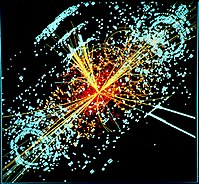
Photo from wikipedia
The proposed Iron Calorimeter (ICAL) at India-based Neutrino Observatory (INO) will be a 50 kt magnetised iron detector for the detection of atmospheric neutrinos. The atmospheric neutrinos interact via both… Click to show full abstract
The proposed Iron Calorimeter (ICAL) at India-based Neutrino Observatory (INO) will be a 50 kt magnetised iron detector for the detection of atmospheric neutrinos. The atmospheric neutrinos interact via both charged current (CC) and neutral current (NC) interactions with the target iron to produce the detectable final state particles. While CC νμ (μ) leave a muon track and a hadron shower in the detector, the NC will leave only a hadron shower apart from the secondary invisible neutrino. A GEANT4 based simulation studies to reconstruct hadron showers in CC and NC, using two techniques namely the Orientation Matrix Method (OMM) and the Raw Hit Method (RHM) are presented here. While OMM requires information about the interaction vertex obtained from muon track reconstruction, RHM requires only the shower hit positions and timings and no vertex information and hence can be used for NC events as well. Hadrons from neutrino events generated with NUANCE neutrino generator are analysed. For hadrons in the energy range 0.5–15 GeV produced in CC νμ and μ interactions, a Δθ'h resolution of around 19o−9o (around 20.5o−12o) is obtained in the |cosθ'h|=[0.8, 1] bin with OMM (RHM). For NC events in the same true energy and direction bins, Δθ'h resolution varies from around 20.5o−13o, from RHM only. OMM (RHM) gives a resolution of about 55o−20o (38o−14o) for the angle between the muon and the hadron shower, βμ h', in the [E'had;cos θ'h] range [0.5–15 GeV; [0.8,1.0]].
Journal Title: Journal of Instrumentation
Year Published: 2018
Link to full text (if available)
Share on Social Media: Sign Up to like & get
recommendations!